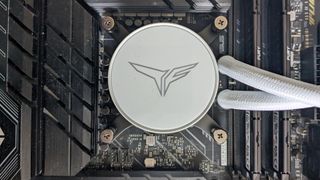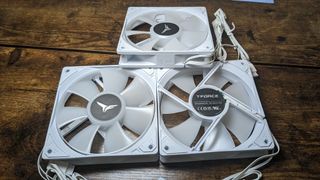Tom's Hardware Verdict
TeamGroup proves that liquid cooling NVMe SSDs can be useful (at least for PCIe 5 drives under heavy load) with it’s Siren Duo 360. But its $399 price makes it hard to recommend, even though it also does a good job of keeping CPU temps under control.
Pros
- +
Cools PCIe 5 SSDs better than traditional solutions
- +
Excellent CPU thermal results
- +
Low noise levels in common workloads
Cons
- -
Very expensive at $399.99
Why you can trust Tom's Hardware
Until pretty recently, cooling storage was at best an afterthought for most enthusiasts and PC builders. When motherboards first started including heatsinks for NVMe drives, in many instances they could actually reduce the performance of an SSD compared to uncooled drives, since flash memory chips are actually designed to run warm.
But current-generation PCIe 5 SSDs can transfer more data than ever before, and with that speed comes lots of extra heat. Not only is some kind of cooling recommended for current PCIe 5 SSDs, it’s often a requirement. These drives will throttle in many workloads without some sort of heat dissipation, and in some instances they can crash without proper cooling.
Manufacturers have been creating many new and unique coolers to tackle this problem, like Thermalright’s unique HR-10 2280 Pro which utilizes both heatpipes and a fan to keep a modern drive cool.
Today we’ll be looking at a unique 360mm AIO from TeamGroup, which cools both your CPU and an M.2 SSD. As such, we’ll be testing this TeamGroup cooler both against other liquid and air coolers like our traditional cooling reviews – but also against other SSD heatsinks.
Specs
| Cooler | TeamGroup T-Force Siren DUO360 AIO |
| MSRP | $399.99 |
| Radiator Material | Aluminum |
| Pump Speed | 4000 RPM ±10% |
| Pump Flow | 850ml/min |
| Pump MTTF | Unlisted |
| Socket Compatibility | Intel LGA 1700/115x/1200/1366/2011(v3)/2066 |
| Row 7 - Cell 0 | AMD: AM5/AM4/FM2(+)/FM1/AM3(+)/AM2(+) |
| Base (CPU & SSD) | Copper |
| Max TDP (Our Testing) | ~250W on Intel i7-13700K |
| Installed Size (with fans) | 396mm (L) x 120mm (W) x 52mm (D) |
| Warranty | 5 years |
Packing and Included Contents

TeamGroup’s T-Force Siren DUO360 arrives in a box similar is size to most other 360mm AIOs, using molded foam, cardboard, and plastic for the protection.

Included with the package are the following:
- Three 120mm fans
- 360mm radiator with CPU & SSD blocks
- Thermal paste
- PWM splitter cable
- ARGB splitter
- Screwdriver
- Thermal pads
- Cable management Velcro strap
- Mounts for all modern CPUs
LGA 1700 Cooler Installation
The installation of this unique cooler is easy enough, but it does have some compatibility issues with motherboards, which we’ll detail below.
1. As with other AIOs, I would advise installing the fans to the radiator and securing the radiator to your computer case prior to other installation steps. In most cases, this makes the rest of installation easier.

2. Intel users will begin by pressing the backplate against the motherboard and securing it by screwing in the mounting standoffs from the front side of the motherboard.

3. Next, attach the mounting brackets to the CPU block, and then apply thermal paste to the CPU.
4. Place the CPU block on top of the standoffs and secure it with the included screws.

5. Now it’s time to get the SSD block installed.
This part is where motherboard compatibility can be tricky. To prevent the cooler’s SSD block from causing compatibility issues with other parts, you’ll need to have an M.2 slot directly below the CPU, and one specifically with its data/pin connections facing the front of your computer case, or one that is next to the RAM slots.

Motherboards that don’t meet these requirements may have problems. I originally intended to test this unit on an ASUS TUF motherboard. On this motherboard, the pins of the m.2 connection faced the rear of the computer. The problem this created is that one of the SSD block’s tubes would either hit the VRM heatsinks, preventing installation, or the other tube would interfere with the PCIe slot below it, preventing installation of a graphics card.

Assuming you don’t have motherboard compatibility issues, installing the SSD block is relatively simple. You’ll take the base of the unit and install the first thermal pad. Then, set the M.2 SSD on top of the thermal pad and place another thermal pad on top of the SSD. In essence, you’ll end up with your SSD sandwiched between the two thermal pads.


Next, place the base with the SSD against the SSD block and secure it with the included screwdriver. Place the lighting lid on top of the SSD block, if you prefer ARGB lighting. Finally, install the SSD block like you would a normal M.2 drive.

6. Connect the PWM and ARGB headers, and don’t forget to take off the plastic peel before turning on your computer.

Features of the T-Force Siren Duo 360 AIO
*️⃣ SSD cooling block
The stand-out feature of the Siren Duo 360 is the inclusion of an SSD block, which allows the AIO to cool both the CPU and a modern SSD. It, like the CPU block, utilizes a full copper base for ideal thermal efficiency. Is this just a gimmick, or does it actually serve a purpose? We’ll find out soon in the thermal benchmarks section.


*️⃣Pure copper contact plate
This AIO arrives with a pure copper CPU contact plate, like most others on the market.

*️⃣Fully rotatable tubing
The tubing of the liquid cooler can be rotated in any direction, making installation easier.

*️⃣27mm-thick radiator
The AIO includes a radiator 27mm thick. With fans installed, the thickness is a total of 52mm.

*️⃣Full RAM compatibility
As the AIO’s CPU block doesn’t overhang or interfere with a motherboard’s DIMM slots in any manner, you are free to use any size of RAM not matter how tall without any worries of incompatibility.

*️⃣Accessible refill port
While you shouldn’t need to refill this unit’s coolant at any time during the duration of it’s warranty, TeamGroup provides an accessible refill port, should you need to do so. Unlike other manufacturers, the company also doesn’t include a technically illegal “warranty void if removed” sticker on the port, to trying to scare you away from servicing your own equipment.

*️⃣Integrated radiator pump
While most AIOs on the market are based on Asetek designs, which incorporate the water pump into the CPU block, TeamGroup’s AIO utilizes a high speed pump integrated into the unit’s radiator.

*️⃣Three 120mm CF1225H12S fans
There’s more to a cooler than just the heatsink or radiator. The bundled fans have a significant impact on cooling, noise levels, and the unit’s aesthetic appeal. The fans included are listed as model CF1225H12S, which aren’t sold separately at this time. These fans sport seven blades and are designed for use with liquid cooling radiators. These fans also include helpful arrows indicating the direction they should be installed, which can be useful for new system builders.

| Model | Sickleflow Edge |
| Dimensions | 120 x 120 x 25mm |
| Fan Speed | 600- 2200RPM ± 300RPM |
| Air Flow | Up to 70.07 CFM |
| Air Pressure | Up to 3.88 mmH2O |
| Bearing Type | Unlisted |
| Lighting | ARGB |
| MFFT | Unlisted |

LGA1700 Socket Bending
Note there are many factors other than the CPU cooler that can influence your cooling performance, including the case you use and the fans installed in it. A system's motherboard can also influence this, especially if it suffers from bending, which results in poor cooler contact with the CPU.
In order to prevent bending from impacting our cooling results, we’ve installed Thermalright’s LGA 1700 contact frame into our testing rig. If your motherboard is affected by bending, your thermal results will be worse than those shown below. Not all motherboards are affected equally by this issue. I tested Raptor Lake CPUs in two motherboards. While one showed significant thermal improvements after installing Thermalright’s LGA1700 contact frame, the other motherboard showed no difference in temperatures whatsoever. Check out our review of the contact frame for more information.
Testing Methodology
Modern high-end CPUs, whether Intel or AMD, are difficult to cool in intensive workloads. In the past reaching 95C+ on a desktop CPU might have been a cause for concern – but with today’s processors, it is considered normal operation. Similar behavior has been present in laptops for years due to cooling limitations in tight spaces.
All testing is performed with a 23C ambient room temperature. Multiple thermal tests are run on each CPU to test the cooler in a variety of conditions, and acoustic measurements are taken with each result. These tests include:
1. Noise normalized testing at low noise levels
2. “Out of the box”/Default Configuration Thermal & Acoustics Testing
a.) No power limits enforced
b.) Because CPUs hit Tjmax in this scenario, the best way to compare cooling strength is by recording the total CPU package power consumption.
3. Termal & Acoustics testing in Power Limited Scenarios
a.) Power limited to 175W to emulate a medium intensity workload
b.) Power limited to 125W to emulate a low intensity workload
The thermal results included are for 10-minute testing runs. To be sure that was sufficiently long to tax the cooler, we tested both Thermalright’s Assassin X 120 R SE and DeepCool’s LT720 with a 30-minute Cinebench test with Intel’s i9-13900K for both 10 minutes and 30 minutes. The results didn’t change much at all with the longer test: The average clock speeds maintained dropped by 29 MHz on DeepCool’s LT720 and 31 MHz on Thermalright’s Assassin X 120 R SE. That’s an incredibly small 0.6% difference in clock speeds maintained, a margin of error difference that tells us that the 10-minute tests are indeed long enough to properly test the coolers.
Testing Configuration – Intel LGA1700 Platform
| CPU | Intel Core i7-13700K |
| Motherboard | MSI Z690 A Pro DDR4 |
| Case | Be Quiet! Silent Base 802, system fans set to speed 1 setting. |
| Monitor | LG 45GR95QE |
| PSU | Cooler Master XG Plus 850 Platinum PSU |
| SSD | 2TB TeamGroup Z540 PCIe 5 SSD |

Albert Thomas is a contributor for Tom’s Hardware, primarily covering CPU cooling reviews.
